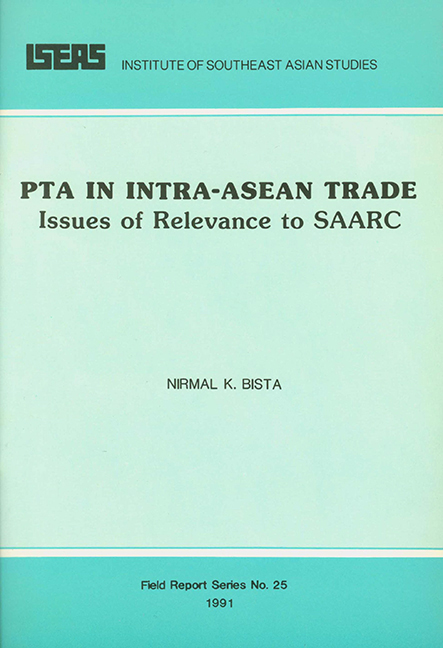IV - Prospects for Trade Expansion through PTA in the SAARC Countries: Lessons from ASEAN
Published online by Cambridge University Press: 21 October 2015
Summary
Overview
Trade expansion has been an integral constituent in almost all of the regional groupings. The SAARC on the other hand has so far identified 12 sectors for mutual co-operation which excludes trade co-operation. A total of 270 activities relating to seminars, workshops, technical committee meetings, training, etc. have not incorporated any trade related issues. The apprehension that co-operation in trade may be difficult to achieve under divergent political and economic systems adopted by the regional countries has so far precluded this vital aspect from its framework. However, there have been interactions among academics and businessmen focusing on trade related issues. In September 1988, an SAARC group of experts in its meeting held in Islamabad initiated a move to prepare the groundwork on SAARC co-operation in trade, manufacturing, and services.
Trade co-operation in the SAARC region by no means is a smooth process. Economic and trade co-operation in trade expansion in the SAARC region is largely dependent upon political situations. The ethnic problem in Sri Lanka and the India-Pakistan dispute over Kashmir are some of the burning political problems in the process of regionalism in South Asia.
South Asian trade is marginal in relation to world trade. That it has not been increasing over the years indicates that prevailing arrangements are not effective enough to trigger the process of development through trade co-operation in the region. The countries in the region are operating highly protected trade regimes. Tariffs and NTBs are considered quite high in India, Pakistan and Bangladesh while they are relatively low in Nepal and Sri Lanka.
Even in the absence of the SAARC multilateral framework, most SAARC countries can exchange tariff preferences among them under the Bangkok Agreement within the framewrok of ESCAP. The Bangkok Agreement initially had three South Asian countries, viz., India, Bangladesh, and Sri Lanka apart from other non-SAARC nations.
- Type
- Chapter
- Information
- PTA in Intra-ASEAN TradeIssues of Relevance to SAARC, pp. 17 - 21Publisher: ISEAS–Yusof Ishak InstitutePrint publication year: 1991



